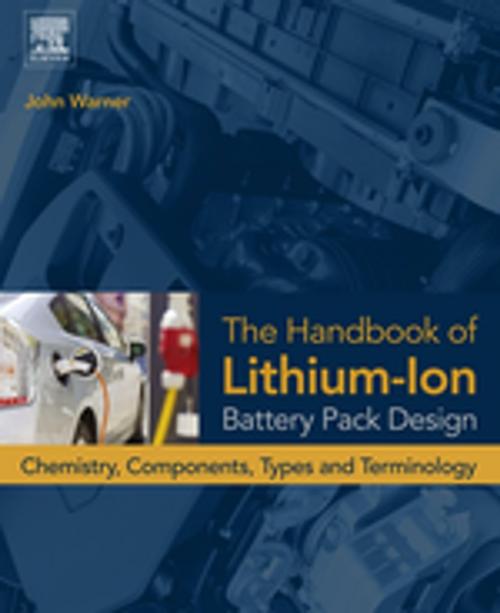The Handbook of Lithium-Ion Battery Pack Design
Chemistry, Components, Types and Terminology
Nonfiction, Science & Nature, Science, Chemistry, Technical & Industrial, Technology| Author: | John T. Warner | ISBN: | 9780128016688 |
| Publisher: | Elsevier Science | Publication: | May 23, 2015 |
| Imprint: | Elsevier Science | Language: | English |
| Author: | John T. Warner |
| ISBN: | 9780128016688 |
| Publisher: | Elsevier Science |
| Publication: | May 23, 2015 |
| Imprint: | Elsevier Science |
| Language: | English |
The Handbook of Lithium-Ion Battery Pack Design: Chemistry, Components, Types and Terminology offers to the reader a clear and concise explanation of how Li-ion batteries are designed from the perspective of a manager, sales person, product manager or entry level engineer who is not already an expert in Li-ion battery design. It will offer a layman’s explanation of the history of vehicle electrification, what the various terminology means, and how to do some simple calculations that can be used in determining basic battery sizing, capacity, voltage and energy. By the end of this book the reader has a solid understanding of all of the terminology around Li-ion batteries and is able to do some simple battery calculations.
The book is immensely useful to beginning and experienced engineer alike who are moving into the battery field. Li-ion batteries are one of the most unique systems in automobiles today in that they combine multiple engineering disciplines, yet most engineering programs focus on only a single engineering field. This book provides you with a reference to the history, terminology and design criteria needed to understand the Li-ion battery and to successfully lay out a new battery concept. Whether you are an electrical engineer, a mechanical engineer or a chemist this book helps you better appreciate the inter-relationships between the various battery engineering fields that are required to understand the battery as an Energy Storage System.
- Offers an easy explanation of battery terminology and enables better understanding of batteries, their components and the market place.
- Demonstrates simple battery scaling calculations in an easy to understand description of the formulas
- Describes clearly the various components of a Li-ion battery and their importance
- Explains the differences between various Li-ion cell types and chemistries and enables the determination which chemistry and cell type is appropriate for which application
- Outlines the differences between battery types, e.g., power vs energy battery
- Presents graphically different vehicle configurations: BEV, PHEV, HEV
- Includes brief history of vehicle electrification and its future
The Handbook of Lithium-Ion Battery Pack Design: Chemistry, Components, Types and Terminology offers to the reader a clear and concise explanation of how Li-ion batteries are designed from the perspective of a manager, sales person, product manager or entry level engineer who is not already an expert in Li-ion battery design. It will offer a layman’s explanation of the history of vehicle electrification, what the various terminology means, and how to do some simple calculations that can be used in determining basic battery sizing, capacity, voltage and energy. By the end of this book the reader has a solid understanding of all of the terminology around Li-ion batteries and is able to do some simple battery calculations.
The book is immensely useful to beginning and experienced engineer alike who are moving into the battery field. Li-ion batteries are one of the most unique systems in automobiles today in that they combine multiple engineering disciplines, yet most engineering programs focus on only a single engineering field. This book provides you with a reference to the history, terminology and design criteria needed to understand the Li-ion battery and to successfully lay out a new battery concept. Whether you are an electrical engineer, a mechanical engineer or a chemist this book helps you better appreciate the inter-relationships between the various battery engineering fields that are required to understand the battery as an Energy Storage System.
- Offers an easy explanation of battery terminology and enables better understanding of batteries, their components and the market place.
- Demonstrates simple battery scaling calculations in an easy to understand description of the formulas
- Describes clearly the various components of a Li-ion battery and their importance
- Explains the differences between various Li-ion cell types and chemistries and enables the determination which chemistry and cell type is appropriate for which application
- Outlines the differences between battery types, e.g., power vs energy battery
- Presents graphically different vehicle configurations: BEV, PHEV, HEV
- Includes brief history of vehicle electrification and its future















